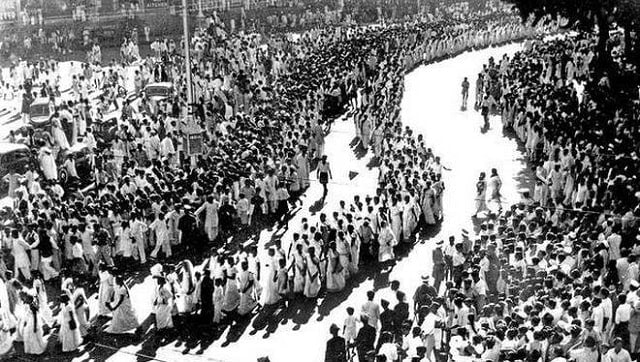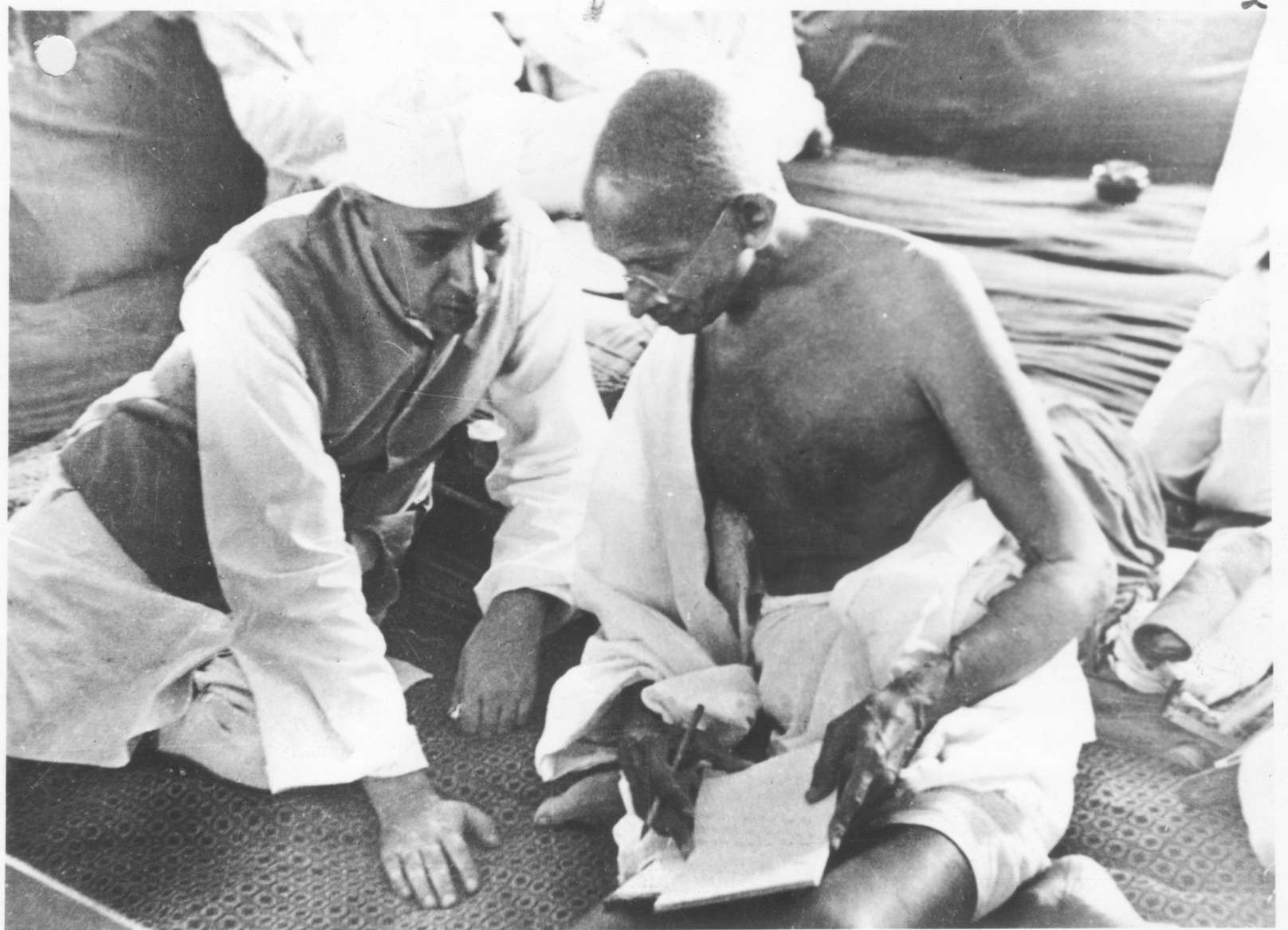
During World War II, a “Do or die” sentiment was heightened worldwide, but the echo was also felt in India through one of the most significant movements, the Quit India Movement, launched by Mahatma Gandhi on August 8, 1942. During World War II, this movement was launched at the Bombay session of the All India Congress Committee. This mass civil disobedience movement, also popularly known as the “August Movement” or "Bharat Chhodo Andolan”, demanded an end to British rule in India.
The slogan ‘Quit India’ was coined by a lesser-known hero of the Indian struggle movement, Yusuf Meherally, a socialist and trade unionist & even served as Mayor of Mumbai. Meherally had also coined the slogan “Simon go back”.
This article discusses the causes, timeline, consequences and failure of the Quit India Movement. So, let’s get started.
Causes of Quit India Movement
 Source: Firstpost
Source: Firstpost
On the launch date of the Quit India Movement, Mahatma Gandhi called to end British rule, which was when he gave the call “Do or Die” in his speech delivered at the Gowalia Tank Maidan (now known as August Kranti Maidan). On the other hand, Aruna Asaf Ali, popularly referred to as the 'Grand Old Lady' of the Independence Movement, is well-known for hoisting the Indian flag at this Gowalia Tank Maidan in Mumbai during the Quit India Movement. Let's understand this in bits & pieces:
-
World War II had started in 1939, and Japan, being part of the Axis Powers, were gaining onto the northeastern frontiers of India.
[The Axis powers (Germany, Italy, Japan) were opposed by the Allied Powers (led by Great Britain, the United States, and the Soviet Union). India was a part of allied nations as it was a part of the British empire back then.]
-
As the Britishers abandoned their territories in South-East Asia & left the people helpless, the Indian population started having doubts about the British ability to defend India against Axis aggression.
-
Also, Gandhiji believed if the Britishers left India, then Japan (the Axis power) would not have enough reason to invade India out of grudges against Great Britain.
-
Later on, apart from knowing the Britisher's betrayal in the war by abandoning their territories, war difficulties such as high prices of essential commodities were also a growing concern, fostering resentment against the British government.
-
The failure of the Cripps Mission to guarantee any constitutional remedy to India’s problems also led to the Indian National Congress calling for a mass civil disobedience movement.
[Cripps Mission was an attempt by the British government to secure the cooperation from Indians in World War II]
/content-assets/31b3ddad81324cc38e63af86acaf4083.jpeg) Source: Open Magazine
Source: Open Magazine
Timeline of Quit India Movement
-
The Quit India movement began on August 8th, 1942 which was passed at the Wardha Conference of All India Congress Committee in July 1942.
-
The slogan ‘Quit India’ & ‘Simon go back’ was coined by Yusuf Meherally, a socialist and a trade unionist.
-
Gandhiji delivered his speech at the Gowalia Tank Maidan, also known as August Kranti Maidan, in Mumbai, marking the commencement of the movement
-
The British government arrested Several national leaders, such as Mahatma Gandhi, Abdul Kalam Azad, Jawaharlal Nehru and Sardar Vallabhbhai Patel.
-
The event was followed by an uproar among the people and the emergence of several young leaders such as Ram Manohar Lohia, Jai Prakash Narayan, SM Joshi, and others who continued to fuel the fire of the movement throughout India during the period of World War II.
-
The movement failed due to lack of leadership.
Boycotting Simon Commission with Simon Go Back
 Source: History Flame
Source: History Flame
Simon Commission, or the Indian Statutory Commission, was a group of 7 Members of Parliament led by Sir John Simon. The commission came to British India in 1928 to study constitutional reforms in Britain’s largest & most significant possession. As the name suggests, the Simon Commission was named after its Chairman, Sir John Simon. The British Government introduced Diarchy (govt. having two joint rulers) under the Government of India Act 1919 to appoint a working commission to review the overall progress in India after ten years.
There was strong opposition against this Diarchy based government from renowned politicians such as Jawaharlal Nehru, Gandhi, Jinnah, the Muslim League, and Indian National Congress as they were not taken into confidence while formulating the report. Basically, there was no Indian control, and all crucial power was in the hands of the British. Ultimately in 1928, amid mass demonstrations, Simon Commission when landed in India, and and people resorted to the slogans “Go Simon Go” and “Go Back Simon”.
Response to Quit India Movement
 Source: The Wire
Source: The Wire
-
The Britishers responded against Gandhi’s initiative by arresting all major Congress leaders, such as Nehru, Patel etc., the very next day. This left the movement in the hands of younger leaders like Jayaprakash Narayan and Ram Manohar Lohia & New leaders such as Aruna Asaf Ali emerged due to lack of leadership.
-
The government started the violence. There were mass floggings and lathi charges, but there was no communal violence.
-
The INC was banned and leaders were sent behind bars. And Gandhiji was released due to health problems in 1944.
-
As the leaders were arrested, in the absence of leadership, there were many incidences of violence and destruction to government property.
-
Some parties did not support the movement, like the Muslim League, the Communist Party of India and the Hindu Mahasabha.
-
The Communist party supported the war waged by the British since they were an ally with the Soviet Union.
-
The League was not in favour of the British leaving India without the partition of India into two dominions.
-
At this time, Subhas Chandra Bose was organizing the Indian National Army and the Azad Hind government from outside the country.
-
C Rajagopalachari, resigned from the INC since he was not in favour of full independence.
-
Even after the lack of support for the movement by the communist group, workers provided support by not working in the factories.
-
At a few places, parallel governments were also set up, such as Ballia, Tamluk, Satara.
-
The hotspots of the movement were UP Bihar, Maharashtra, Midnapore, and Karnataka.
-
The movement lasted till 1944.
What was the result of Quit India movement?
 Source: Wikipedia
Source: Wikipedia
Quit India movement failed as it did not address the prime demand of self-government, and there was no guidance from the Congress leaders because the most significant leaders had been sent behind bars, and the organisation itself was declared illegal. So, Quit India did not have a specific programme of action. Therefore, it ultimately failed.
Competitive Exam Questions on Quit India Movement
1. When was the Quit India Movement launched?
a. August 8, 1940
b. August 8, 1941
c. August 8, 1942
d. August 8, 1943
2. Who was the primary leader of the Quit India Movement?
a. Jawaharlal Nehru
b. Subhas Chandra Bose
c. Mahatma Gandhi
d. Sardar Vallabhbhai Patel
3. What were the main objectives of the Quit India Movement?
a. Demanding more political rights within the British Raj
b. Seeking complete independence from British rule
c. Advocating for greater economic reforms
d. Supporting the British government in World War II
4. How long did the Quit India Movement last?
a. 6 months
b. 1 year
c. 2 years
d. 4 years
5. What was the British government's response to the Quit India Movement?
a. Granting complete independence to India
b. Imposing strict censorship and curfews
c. Supporting the demands of the Indian leaders
d. Ignoring the protests and demonstrations
6. Which leaders were NOT associated with the Quit India Movement?
a. Maulana Abul Kalam Azad
b. Bhagat Singh
c. Sarojini Naidu
d. Jawaharlal Nehru
Answers: 1.c, 2.c. 3.b, 4.c, 5.b, 6.b